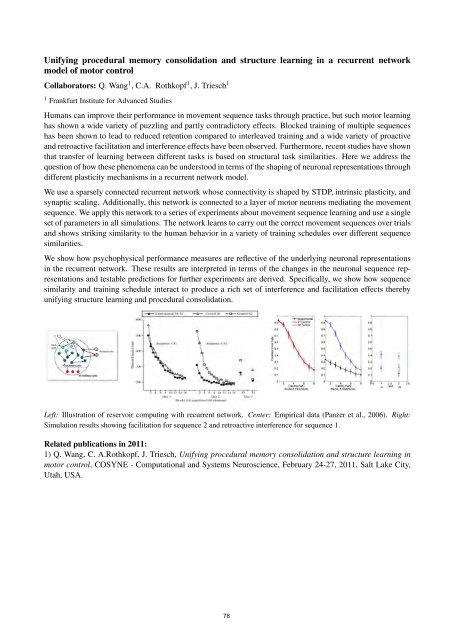FIAS Scientific Report 2011 - Frankfurt Institute for Advanced Studies ...
FIAS Scientific Report 2011 - Frankfurt Institute for Advanced Studies ...
FIAS Scientific Report 2011 - Frankfurt Institute for Advanced Studies ...
Create successful ePaper yourself
Turn your PDF publications into a flip-book with our unique Google optimized e-Paper software.
Unifying procedural memory consolidation and structure learning in a recurrent network<br />
model of motor control<br />
Collaborators: Q. Wang 1 , C.A. Rothkopf 1 , J. Triesch 1<br />
1 <strong>Frankfurt</strong> <strong>Institute</strong> <strong>for</strong> <strong>Advanced</strong> <strong>Studies</strong><br />
Humans can improve their per<strong>for</strong>mance in movement sequence tasks through practice, but such motor learning<br />
has shown a wide variety of puzzling and partly contradictory effects. Blocked training of multiple sequences<br />
has been shown to lead to reduced retention compared to interleaved training and a wide variety of proactive<br />
and retroactive facilitation and interference effects have been observed. Furthermore, recent studies have shown<br />
that transfer of learning between different tasks is based on structural task similarities. Here we address the<br />
question of how these phenomena can be understood in terms of the shaping of neuronal representations through<br />
different plasticity mechanisms in a recurrent network model.<br />
We use a sparsely connected recurrent network whose connectivity is shaped by STDP, intrinsic plasticity, and<br />
synaptic scaling. Additionally, this network is connected to a layer of motor neurons mediating the movement<br />
sequence. We apply this network to a series of experiments about movement sequence learning and use a single<br />
set of parameters in all simulations. The network learns to carry out the correct movement sequences over trials<br />
and shows striking similarity to the human behavior in a variety of training schedules over different sequence<br />
similarities.<br />
We show how psychophysical per<strong>for</strong>mance measures are reflective of the underlying neuronal representations<br />
in the recurrent network. These results are interpreted in terms of the changes in the neuronal sequence representations<br />
and testable predictions <strong>for</strong> further experiments are derived. Specifically, we show how sequence<br />
similarity and training schedule interact to produce a rich set of interference and facilitation effects thereby<br />
unifying structure learning and procedural consolidation.<br />
Left: Illustration of reservoir computing with recurrent network. Center: Empirical data (Panzer et al., 2006). Right:<br />
Simulation results showing facilitation <strong>for</strong> sequence 2 and retroactive interference <strong>for</strong> sequence 1.<br />
Related publications in <strong>2011</strong>:<br />
1) Q. Wang, C. A.Rothkopf, J. Triesch, Unifying procedural memory consolidation and structure learning in<br />
motor control, COSYNE - Computational and Systems Neuroscience, February 24-27, <strong>2011</strong>, Salt Lake City,<br />
Utah, USA.<br />
78
















